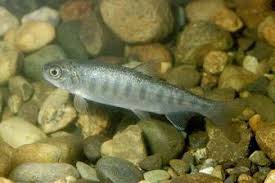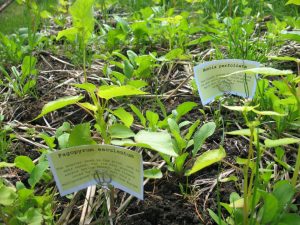Early Spring
March 20 to May 1
Springtime begins on the Vernal Equinox in late March. The balance of light and dark has been celebrated around the world since time before memory, and is now remembered as Nawruz, Higan, Easter or Passover. Days lengthen and shoots and flowers spill from swelling buds. By Mayday, the green cloak is renewed and, Springtime turns to Bloom.
During Springtime, the soil temperature warms triggering germination and growth. Cyclonic storms may still come, and frost on clear nights. Those who think about water in a changing climate are measuring snow pack and hoping for spring rains and strong growth before the droughts .
Wild Creatures and Wildcraft

The wild salmon are on the move. Fry float downstream foraging and lurk in shadow, trying to stay alive. Many creatures gather for the feast of baby salmon. Each fry finds its niche. The coho seek still water to rear, while chum slip quickly to saltwater marsh and eelgrass meadows. Even a single species may divide into life history groups, following different paths, to find the unique opportunities of each river, imprinted in genetic memories.
Spring perennial greens flush and are at their most tender, even before the spring kitchen garden begin to germinate: nettles, fiddleheads and diverse young shoots form a nutrient dense “spring tonic”. Many of the best greens are ephemeral, and quickly become bitter with the bloom. Bags of nettles go directly in the freezer. With the spring comes the once-a-year flow of sap–not as heavy with ritual as among the Eastern sugar maples, but still a significant for easily stripping bark for fiber.
Over spring time, the dawn chorus slowly grows to a crescendo. As the days get longer, you might take a walk at dawn before the day begins, and hear one of natural wonders of the world, as birds from every forest strata stake their claim.
REVegetation

We hope we are done transplanting, but there are always stragglers. In springtime you get to see the efficacy of last years disturbances, any tilling and mulching to create gaps into which we insert plants. Root fragments and seed banks spring anew, to compete with out-plantings and sown seeds. Any weakness in site preparation, planting stock, or installation becomes evident to sensitive eyes over springtime.
Unless you are in wetlands, this is your one solid and reliable season of growth before the summer drought begins menacing young plants. Seeds scattered in fall and spring germinate in this momentary overlap between winter wet and summer warmth. Some may mulch with stockpiles of tree service wood chips, but growth is still slow, such that spring mowning of hay mulch won’t really begin until Bloom, except on the warmest of sites.
In an ideal world we are finishing the design work for the plantings that will go in the ground next winter: planning site preparation, calculating areas and stock counts, so we can count our stock, get in line for purchasing from growers, or plan field collection of cuttings. If you are custom growing for unusual species, you may be looking two seasons ahead, and setting targets for seed collection.
Organized project managers are making plant orders to reserve uncommon stock before the summer rush. Green shoots begin to emerge, allowing more efficient and complete site assessment of species composition on new sites.
THE Garden

The first waves of seeding and transplanting of cool season crops begin in springtime. four plant families dominate the cool-weather garden: Spinach (Chenopodaceae), Mustard (Brassicaceae), Carrot (Apiaceae) and Lettuce (Compositae). Root crops are planted from seed, while in intensive gardens, greens are often transplanted to maximize the use of space.
Tillage gardens are in constant motion, with a constant flow of bed preparation, seeding, watering, and transplanting. Semi-wild gardens spring to life from seed and root with less supervision and effort. Being able to recognize seedlings of diverse species is important for reading the trajectory of a semi-wild garden. Springtime pasture cuttings and lawn clippings can make good mulch even in more refined gardens, with short tidy stems and few seeds. Many winter-germinating weeds find their way into salads.
Project Management and Hazards
Springtime weather is in constant flux. Permits are well in the cue for any dry season construction. Requests for new information can stall the clock. The full project slate for summer and fall is starting to come into focus.
There is the the potential for rain on snow events in the mountains. Snow fed streams can be scoured by spring freshets that leave the banks and rework floodplains. In rivers and streams confined or incised from development, floods flush salmon to the sea, before they are ready, and weaken the river rearing segments of the population.
Politics and Government
In the Washington state legislature, the casualties pile up. Bills die quietly in the corners of legislative committees. Well supported pairs of bills walk confidently out of senate and house. Sometimes rumpled and mismatched bills define future negotiations. The policy dynamics of the legislature is coming into focus, as the resolve and interests of legislators are tested and revealed.
In odd years, the Washington State biennial budget is a battleground, in two waves: the operating budget is first, funding the executive agencies. The capital budget comes second, refined by revenue predictions. The factors affecting each are different, but together they determine the capabilities of government for the next two years. Off-year adjustments to these big biennial budgets rarely add up to much.
On the national stage there may still be no federal budget for the fiscal year already thorough its second quarter. Over the last decade or longer, “continuing resolutions” have become the method of managing the nations finances. Even after appropriations, programs may wait as internal agency politics, further apportion the budget line, until a final verdict is delivered to offices, divisions, and programs . Bureaucrats spend the next three seasons trying to stuff resources through contracting and grant making systems before end-of-year cutoffs sweep those that can’t spend fast enough.
Even as the current federal fiscal year comes into clarity, the struggle for the next federal budget year begins. Perhaps in Budswell we first see the “Pres Bud” or the official presidential budget for the executive branch. But that executive proclamation, is only an opening move, and does not appropriate funds. Lobbyists begin exercising their networks to support their favorite programs in the legislature.
Against the backdrop of legislation and budgets, there is renewed electioneering and the spring recess in April. In even years, a proportion of each state delegations prepares for their election campaigns and challengers and their patrons line up to wrest power from sitting representatives. Political battles can spill over from the floor of the legislature into the streets of local districts and back again. The governing work and the electoral show are muddled together.
Local governments watch carefully, as their work may hinge and shift on a sudden decision or demand at the state and federal level. In return, local governments are a motivated player within the state and federal arena, living at the downstream end of a food chain of funding and rules.
Previous: Budswell
Next: Bloom
This post is part of a standing body of work to capture the seasonal nature of our social-ecological lives, and how they might apply to the work of the Ecosystem Guild and Restoration Camping.


